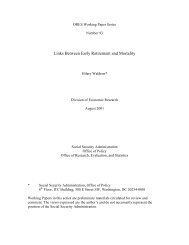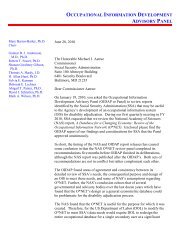Download entire publication - Social Security
Download entire publication - Social Security
Download entire publication - Social Security
You also want an ePaper? Increase the reach of your titles
YUMPU automatically turns print PDFs into web optimized ePapers that Google loves.
within the next few years (Aglira 2006; Gebhardtsbauer2006; McKinsey & Company 2007).This is essentially what happened in the UnitedKingdom (U.K.) with private-sector DB pensions.When the British adopted transparent financialaccounting standards and the government taxed pensionplan accumulations it deemed to be excessive,the percent of assets “in terminated or frozen status”increased from 35 percent in 1998 to 70 percent in2006 (Munnell and Soto 2007). A Towers Perrin 2008survey of private employers in the United Kingdomdocumented the shift away from DB pensionsthrough plan freezes and found that the percentageof new employees able to join a DB plan declinedfrom 67 percent in 2002 to only 11 percent in 2008.Almost half of employers surveyed expected to makefurther changes to their pension schemes in the next5 years, partly in response to personal account legislationproposed to become effective in 2012 (TowersPerrin 2008).The future prospects for DB pension plans in thepublic sector are more favorable. Very little of the shiftfrom DB to DC plans has occurred in the public sector(Anderson and Brainard 2004; Broadbent, Palumbo,and Woodman 2006; Munnell, Haverstick, and Soto2007; Turner and Hughes 2008). Although somestate and local governments in the United States haveintroduced DC plans in some form or another, onlyMichigan and Alaska have primary plans that requirenew employees to join a DC plan. Other states thathave introduced DC plans have maintained their DBplans (Munnell and others 2008). Additionally, unlikein the private sector where the primary motivation forestablishing DC plans is economic, in the public sectorthe primary motivation appears to be political (Munnelland others 2008).Nonetheless, public-sector DB pension plans mayalso face increasing stress in future years. About athird of state and local government pension plans wereless than 80 percent funded in 2006, and the share ofunderfunded plans increased to 46 percent with the2008 stock market crash (Munnell, Aubry, and Muldoon2008b). Correcting the funding deficit in the currentrecession may be particularly difficult as state andlocal tax revenues plummet. Financial and politicalpressures may push some of these government plans tofreeze along with private-sector plans.MethodologyOur analysis is based on projections of the majorsources of retirement income from SSA’s MINTmicrosimulation model, which was developed by theagency’s Office of Research, Evaluation, and Statisticswith substantial assistance from the BrookingsInstitution, RAND Corporation, and Urban Institute.Starting with data from the 1990–1993 and 1996panels of the Census Bureau’s Survey of Incomeand Program Participation (SIPP) matched to SSA’searnings and benefit records through 2004, MINTprojects the future life course of persons born from1926 through 1965. MINT independently projectseach person’s marital changes, mortality, entry toand exit from <strong>Social</strong> <strong>Security</strong> Disability Insurance(DI) rolls, and age of first receipt of <strong>Social</strong> <strong>Security</strong>and pensions benefits. It also projects family incomeincluding <strong>Social</strong> <strong>Security</strong> benefits, pension income,asset income, earnings, Supplemental <strong>Security</strong> Income(SSI), income from nonspouse co-resident familymembers, and imputed rental income. 3MINT directly measures the experiences of surveyrespondents as of the early 1990s—representing thefirst third to the first half of the lives of boomers—and changes in earnings and <strong>Social</strong> <strong>Security</strong> benefitsthrough 2004 using SSA administrative records.MINT then projects individuals’ characteristics andincomes into the future until death, accounting formajor changes in the growth of economy-wide realearnings, the distribution of earnings both betweenand within birth cohorts, and the composition of theretiree population. All of these factors will affect theretirement income of future boomer retirees. 4 Theprojections in this article are based on MINT5. 5 Moredetail on MINT can be found in Appendix A and inSmith and others (2007).Projecting Pensions in MINTMINT projects employer-sponsored DB, DC, andcash balance (CB) pension plans. 6 Pension benefits arebased on an individual’s <strong>entire</strong> work history (real andsimulated) up to the projected retirement date. SIPPself-reported data provide baseline information aboutpension coverage on current and past jobs. The MINTbaseline was recently updated to reflect pension planstructures through December 2006, including DBpension plan freezes and conversions to CB plans. Thepension module uses data from the PENSIM 7 modelto impute future job changes and pension coverageon future jobs from the time of the SIPP interviewthrough age 50. After age 50, the pension moduleassumes that no further job changes take place.With each job separation, MINT projects that someworkers cash out their accumulated DC balances.4 <strong>Social</strong> <strong>Security</strong> Bulletin • Vol. 69 • No. 3 • 2009








